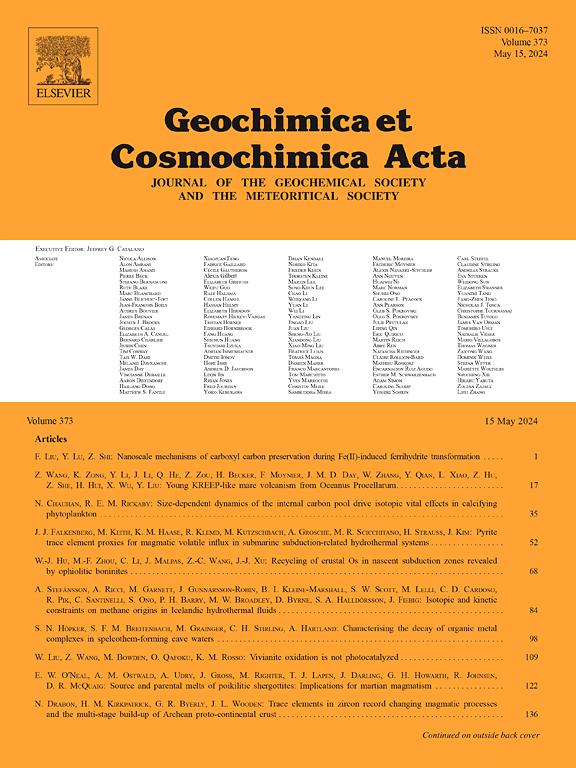花岗岩风化过程中的镓同位素分馏:对比气候条件下两个剖面的见解
IF 5
1区 地球科学
Q1 GEOCHEMISTRY & GEOPHYSICS
引用次数: 0
摘要
最近发展起来的镓(Ga)同位素系统为大陆风化,特别是在强烈化学风化条件下的风化提供了有价值的见解。然而,Ga同位素分馏与硅酸盐风化强度影响因素之间的关系尚待系统探讨。本文报道了在北京温带半干旱气候和广东热带湿润季风气候条件下发育的两个花岗岩风化剖面的Ga同位素组成。我们的研究表明,这些风化剖面中的Ga大部分保留在含al矿物的晶格内,其次是含fe矿物,表面吸附最小。Mössbauer光谱和序列提取结果表明,随着风化强度的增加,溶解的亚铁铁在晚期风化阶段转变为铁铁,Fe对Ga浓度和同位素组成的影响更为显著。两种花岗岩风化剖面的δ71Ga值均表现出由基岩到地表略有降低的趋势(北京剖面:从0.71 ‰到0.61 ‰;广东剖面:0.70 ‰~ 0.54 ‰)。这表明,相对于风化岩石孔隙中共存的水溶液,较轻的Ga同位素(69Ga)优先富集于风化层中,这与玄武岩风化剖面的观测结果一致。在北京剖面中,τGa、Th (a风化指数)和δ71Ga值具有较强的相关性,表明Ga同位素组成主要受原生矿物溶蚀作用的控制。这种相关性表明,δ71Ga值的变化可以作为化学风化早期风化强度的有效示踪剂。然而,这种模式在广东剖面中不存在,那里的Ga同位素组成似乎不仅受到矿物溶解的影响,还受到矿物吸附和共沉淀等过程的影响。将我们的结果与先前发表的Ga同位素组成进行更广泛的比较表明,基岩的岩性是Ga同位素分馏程度的主要控制因素。次生矿物组成和气候条件等因素对化学风化过程中Ga迁移率和Ga同位素分馏也有重要影响。本文章由计算机程序翻译,如有差异,请以英文原文为准。
Gallium isotope fractionation during granite weathering: Insights from two profiles in contrasting climatic conditions
The recently developed gallium (Ga) isotope systematics provides valuable insights into continental weathering, particularly under conditions of intense chemical weathering. However, the relationship between Ga isotope fractionation and the factors influencing the intensity of silicate weathering has yet to be systematically explored. In this study, we report Ga isotope compositions from two granite weathering profiles developed under contrasting climates: a temperate semiarid climate in the Beijing profile and a tropical moist monsoon climate in the Guangdong profile. Our study shows that the majority of Ga in these weathering profiles is retained within the crystal-lattice of Al-bearing minerals, followed by Fe-bearing minerals, with minimal surface adsorption. Mössbauer spectra and sequential extraction results show that the influence of Fe on Ga concentrations and isotope compositions becomes more significant as weathering intensity increases, driven by the transformation of dissolved ferrous Fe into ferric Fe at advanced weathering stages. Both granite weathering profiles exhibit a similar trend of slightly decreasing δ71Ga values from bedrock to surface (Beijing profile: from 0.71 ‰ to 0.61 ‰; Guangdong profile: from 0.70 ‰ to 0.54 ‰). This suggests that the lighter Ga isotope, 69Ga, is preferentially enriched in regolith relative to the coexisting aqueous solution in the pore spaces of weathered rocks, consistent with observations from a basalt weathering profile. In the Beijing profile, a strong correlation between τGa,Th (a weathering index) and δ71Ga values suggests that Ga isotope compositions are mainly controlled by the dissolution of primary minerals. This correlation indicates that variations in δ71Ga values can serve as effective tracers of weathering intensity during early stages of chemical weathering. However, this pattern is absent in the Guangdong profile, where Ga isotope compositions appear to be influenced not only by mineral dissolution but also by processes such as mineral adsorption and coprecipitation. A broader comparison of our results with previously published Ga isotope composition suggests the lithology of bedrock provides the major control on the extent of Ga isotope fractionation. Other factors, including the composition of secondary minerals and the climatic conditions, also play significant roles in influencing Ga mobility and Ga isotope fractionation during chemical weathering.
求助全文
通过发布文献求助,成功后即可免费获取论文全文。
去求助
来源期刊

Geochimica et Cosmochimica Acta
地学-地球化学与地球物理
CiteScore
9.60
自引率
14.00%
发文量
437
审稿时长
6 months
期刊介绍:
Geochimica et Cosmochimica Acta publishes research papers in a wide range of subjects in terrestrial geochemistry, meteoritics, and planetary geochemistry. The scope of the journal includes:
1). Physical chemistry of gases, aqueous solutions, glasses, and crystalline solids
2). Igneous and metamorphic petrology
3). Chemical processes in the atmosphere, hydrosphere, biosphere, and lithosphere of the Earth
4). Organic geochemistry
5). Isotope geochemistry
6). Meteoritics and meteorite impacts
7). Lunar science; and
8). Planetary geochemistry.
 求助内容:
求助内容: 应助结果提醒方式:
应助结果提醒方式:


